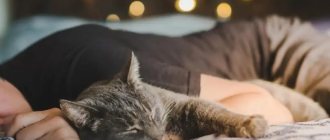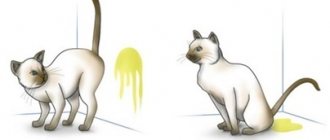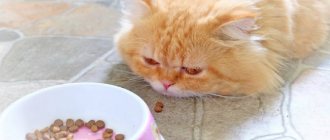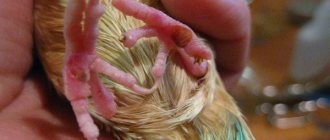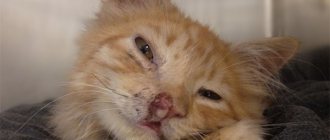The onset of the period of sexual heat is a physiological process indicating the beginning of a new period in the life of an animal. A sexually mature cat is ready to bear and care for offspring.
The first heat in some cats occurs at the age of 7 months, but mixing a female with a male during this period is not recommended, since the body is not yet strong. It happens that a cat's heat is prolonged, causing a lot of trouble for the owner. It is important to understand what leads to prolongation of estrus and how you can help the animal.
Frequency and duration of estrus
There are no exact dates for the onset of estrus in cats. The approximate period is from 7 months to 1.5 years. If a cat begins to “leak” earlier and does not “leak” by the age of one and a half years, then this is a reason to consult a veterinarian.
The onset of estrus indicates that the cat is ready for fertilization and at this time she is actively looking for a partner. However, experts do not recommend mating her with a cat in the first six months after the start of estrus. If the cat does not become pregnant, it goes into heat approximately every two weeks. Each heat lasts on average from 5 to 10 days. If a pet’s love suffering lasts for 12-14 days or more, this is also a reason to contact a veterinarian.
Sexual activity reaches its maximum in late winter and early spring. But there is no direct connection between the period of sexual desire and the time of year in cats. Besides February-March, a cat may want a cat as soon as the production of the hormone progesterone in her body reaches a certain level. On average, estrus occurs 3-4 times a year. Their frequency depends on whether the cat has given birth, the age and breed of the animal. Less temperamental breeds, due to hormonal characteristics, “walk” less often. If a cat is regularly bred, then the sexual appetite is not so pronounced - estrus 2-3 times a year. Age also matters - the older the pet, the faster the heat ends and the less often it happens.
How many times a year does a cat walk?
The frequency of estrus depends on whether the cat has given birth or not. As a rule, cats after giving birth go for walks once every two months, and sometimes once a year. It is impossible to give a definite answer to the question of how long after giving birth the estrus will begin. As a rule, this happens after a month, but it all depends on the specific breed and the nature of the birth.
If the cat has not given birth, estrus occurs quite often - once every two weeks or month. If the owner wants to reduce the frequency of festivities, you can allow the animal to reproduce, or contact a veterinarian to prescribe hormonal medications.
Duration of estrus in different cat breeds
The duration of estrus directly depends on the breed of the pet. British women are known for the rarest periods of festivities. The first heat occurs at the age of 7 months. Over time, the regularity of ovulation and its duration are disrupted;
Scottish women are famous for their early puberty - at 5 months. The duration of estrus is up to 6 days, the frequency is several times a year.
How does estrus manifest in cats?
Physiological changes during estrus affect a cat's behavior. Even an inexperienced owner will understand that those very days have begun. Estrus occurs with characteristic symptoms:
- frequent urination;
- increasing cat cleanliness;
- lack of appetite;
- excessive display of affection - the cat wriggles on the floor, rubs against objects and legs;
- characteristic pose - tail thrown to the side, kicking on the floor;
- inviting meow;
- desire to leave home in search of a partner.
The physiological manifestation of estrus is an increase in the external genitalia, discharge (but without blood, blood is a sign of the disease). Often cats lose weight due to decreased appetite. He will return after the heat.
What to do if the cat does not leak
The absence of estrus is not evidence of any serious diseases in the body. The characteristics of the breed must also be taken into account.
In order to “wake up” the female’s body, the following measures can be taken:
- Take into your home another cat that is in heat. Observing another individual, she will begin to imitate her habits, which will give impetus to the restoration of hormonal balance and the beginning of natural estrus.
- You can also accommodate a cat. Communication with the opposite sex should awaken dormant instincts and contribute to the production of enzymes that help start the process of procreation.
If the measures taken do not lead to the desired result, then it is necessary to examine the animal in a veterinary clinic. The data obtained will help the doctor select medications and a vitamin complex that will restore the cat’s reproductive function. 1111
How to relieve a cat's condition
To make it easier for you and your cat to survive the difficult period of her estrus, follow these helpful tips:
- Distract with games - it is useful to stock up on new toys and invent new entertainment, preferably outdoor games. The more tired the cat is from playing during the day, the more peacefully the cat will sleep at night;
- Pay more attention - calm, caress the pet, pick it up more often so that the cat feels your support;
- Feed on a different schedule - a cat in heat has a decreased appetite, so reduce portions, but offer food more often.
It makes no sense to scold a cat for its physiological characteristics. The animal follows its nature and cannot voluntarily stop calling the cat and worrying. The best option is to be patient and get through this period.
Advice about taking your cat to the shower or locking it in the dark will not help ease or speed up the course of estrus. Sudden swimming will only cause stress, and staying in the dark will make you nervous and adversely affect the nervous system.
A radical option to stop estrus for a while is to breed a cat with a cat. But be prepared for the possible appearance of offspring.
Behavior problems
When cats ask for a date with a cat, household members have a hard time. The constant screaming makes it impossible to sleep at night. Some people can’t stand it and lock their pets in one of the rooms. Others wet the animal’s fur with water in the evenings. This allows you to gain an hour of silence while the cat licks its fur coat. But as soon as she dries up, she starts asking for the cat again. This behavior is exhausting and forces you to try different ways.
Is it possible to calm a cat at home?
Simply petting and calming a cat that asks for a cat is unlikely to work. You will have to be patient and wait until the heat ends.
Numerous “folk” tips on how to calm a pet usually turn out to be ineffective:
- Pet your pet more often. Showing attention will only increase arousal.
- Give sedatives. They will not help because the animal is not stressed. They are driven by the instinct of reproduction. Such medications only slightly dull the desire to mate.
- Feed the cat with products containing pheromones like Feliway. During sexual hunting they are completely useless. Such drugs help to quickly adapt to a new place and to endure the trip more calmly, but they do not pacify natural instincts.
Calming medications for cats
Sometimes veterinarians recommend taking sedatives. Such medications help to dull arousal a little, but their main purpose is to achieve mental lability, eliminate aggression and anxiety.
List of drugs and method of use:
- Cat Baiyun. A medicine based on herbs with a sedative effect - valerian roots, oregano, sweet clover, mint, motherwort, hop cones and others. As soon as the cat begins to ask for a cat, she is given 2 ml of medicine three times a day for 5-7 days.
- Fitex drops. A sedative with herbal components – valerian, motherwort, hop extract. The medicine normalizes the functioning of the central nervous system, muffles the feeling of fear and aggression. If a cat wants a cat, or vice versa, then the pet is given 3-5 drops of the product in the morning, lunch and evening for several days.
- Drops for cats Stop stress. The drug is available in the form of drops and tablets. The medicine contains aminophenylbutyric acid and extracts of valerian, catnip, hops and motherwort. This remedy helps reduce agitation and correct the animal's behavior in stressful situations. Directions for use: 1 drop per 1 kg of weight twice a day.
Sedatives should not be given to a cat for a long time. They are allowed to be used for no more than 10 days. And you should not expect that these medications will completely eliminate sexual arousal. They can only slightly smooth out the symptoms of estrus.
Artificial ovulation
Sometimes the safest and most effective way to calm a cat so that she does not ask for a cat is to artificially induce ovulation. This method is suitable if the pet cannot be given for mating right now for some reason. For example, if she is in her first heat or a worthy candidate for mating has not yet been found.
In some cases, veterinarians show owners how to simulate sexual intercourse at home, which will cause ovulation. To do this, you will need a small phallic-shaped object about 4-5 mm thick and 1.5-2 cm long. A cotton swab wrapped in a fingertip or something similar will do. The cat is held by the withers. When she is in the mating position, the object is gently inserted into her vagina.
It is recommended to repeat this procedure 3-4 times within 12 hours. After this, the pet should ovulate, which will provoke a false pregnancy.
The heat will stop, the cat will calm down, stop asking for the cat and will prepare for the appearance of kittens. Some females begin to arrange a place for birth. During a false pregnancy, hormonal changes occur, so milk may be released from the mammary glands.
Attention! The artificial ovulation technique cannot be used every time the cat asks for a cat. This can cause inflammation in the uterus.
What not to do
Some actions of owners can harm the cat. For example, you cannot lock an animal in a cellar or bathroom. Being alone will have a negative impact on your mental health.
It is also undesirable to let your cat outside unattended, because it could get hit by a car, contract a virus, or become a victim of aggressive dogs. In addition, uncontrolled walking during estrus can lead to mating with an outdoor cat.
You should not punish her, yell at her, or hit her. This will not help solve the problem, because the animal is at the mercy of instincts. The pet will still continue to scream and roll on the floor.
Hormonal drugs: benefits and harms
Veterinary pharmacies offer tablets and drops that relieve symptoms of estrus. They have a calming effect and will help you survive the period of estrus. But such means will help the person first of all - you will not be annoyed by incessant meowing and inappropriate affection. Calming drugs affect the cat’s hormonal levels, inhibiting them. There will be nothing useful from such a product for the cat’s health. They should be given with extreme caution! They are strictly prohibited for young animals under the age of five; in all other cases they are given only sporadically, as an exception. You cannot “comfort” a cat during every heat!
Hormonal drugs have the power to, among other things, delay or stop an estrus that has already begun. In some circumstances, this is convenient for the animal owner, but such treatment has a very negative effect on the cat’s health. And even more so, you can’t take them haphazardly!
Hormonal medications can only be taken as prescribed by a veterinarian, after tests show a hormonal imbalance. The background is leveled with homeopathic remedies that normalize female feline health. Homeopathic remedies include infusions and drops that calm the cat. They are used strictly according to the instructions and only after reaching a certain age.
What to do when your cat starts wandering
There are several ways to calm a walking cat:
- sterilization. The most humane and correct method. It will not only relieve the cat from the need to reproduce, but will also protect its health. Neutered cats have a much longer belly than unsterilized cats;
- reduction in diet. Cut down on your cat's portions during heat, feed her generously only at night so that she falls asleep after eating;
- distraction with games. If a cat spends energy playing, she will not have the energy to search for the cat;
- sedatives. In veterinary pharmacies you can buy medicines based on chamomile and other herbs. Of course, they will not completely silence the cat, but they will calm it down a little. The main thing is that herbal natural preparations are safe for your pet’s health.
Some owners prefer to give their pets strong pills like “Contra-Sex” or “Sex Barrier”. This is a huge mistake. Such tablets will really calm the animal. However, in almost 100% of cases, pets develop fatal diseases after taking them!
If your cat is walking and you find it difficult to decide between all the methods described above, contact your veterinarian. He will tell you the most suitable way to calm down your loving pet.
A cat is a very soft and sweet pet that brings a huge amount of joy to every owner. But in addition to a lot of positive emotions, a funny little tiger can also cause a lot of trouble with its temporary problems. Any owner may be taken by surprise by the question of how many days a cat has been walking.
The animal may want to go free swimming due to the onset of puberty. Typically, in older individuals this process begins around the eighth month of life. This process depends on many factors:
- Breeds;
- Physique;
- Heredity;
- Living conditions;
- The presence of adults nearby.
At this time, the pet’s behavior may change dramatically; the cat becomes more active, aggressive and very persistently tries to leave the house. It’s all due to hormones that force the beast to look for a “soul mate.”
for procreation. Not finding an outlet for its energy, a cat that is walking can spend it screaming incessantly day and night, attacking its owners and placing marks throughout the apartment. This means that the cat is ready for sexual intercourse.
To prevent this behavior, you can use special medications or resort to castration. But if you don’t like such methods, then you should stop at the simplest way to rid your cat of a hormonal storm and let him out for a walk. And here you need to know how often the cat walks.
First heat
Typically, a cat's first heat begins between 6 and 10 months of age. Sometimes a four-month-old kitten may go into heat, which is considered a deviation from the norm. In this case, the animal should be shown to a doctor. In some cases, estrus does not begin even after one and a half years of age. This is a signal that something is wrong with the cat's health.
Factors that influence when a cat goes into her first heat:
- Heredity.
- Animal size.
- The presence of a mature cat in the house.
- Health status.
- Does the cat have access to the outside? Outdoor cats often mature earlier. Since the average lifespan of street cats is shorter than that of domestic cats, they try to leave offspring as early as possible.
- Breed.
It is worth noting that a cat’s first estrus may be blurred, without obvious symptoms. The owner may not even know that his pet has already formed and is quite ready for mating. However, even during an asymptomatic period, a cat can become pregnant. This is why keeping kittens of different sexes older than six months together is somewhat risky.
Cat puberty occurs earlier than physical maturation. This is why you should not mate a female during her first heat: this can lead to a difficult pregnancy, problems during childbirth, and behavioral disorders (it happens that mothers who are too young do not want to take care of their kittens).
Often, breeders mate cats for the first time at the age of one and a half years, when the female has already gone through 2-3 heats. At this age, the cat is already old enough, and the risks of pregnancy are minimized.

